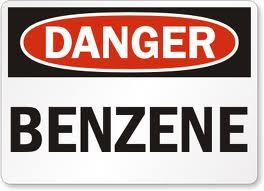Benzene Exposure Causes Leukemia
A Benzene leukemia lawsuit is a personal injury or wrongful death claim brought against the manufacturer of a product containing Benzene, that the worker was exposed to, and that caused his personal injury.

A Benzene leukemia lawsuit alleges that the manufacturer of the product that contained Benzene failed to warn consumers or workers of the injury risks associated with Benzene exposure from using their product.
A Benzene leukemia lawsuit alleges that the person bringing the lawsuit suffered a specific harm as a result of the Benzene exposure. This is known as “causation”. And that harm led to damages, both economic (lost wages and hospital bills) and non-economic such as pain and suffering.
Benzene exposure can cause leukemia, particularly acute myeloid leukemia (AML), through a complex process that involves the disruption of normal blood cell production in the bone marrow. The mechanism by which benzene causes leukemia involves several biological processes:
- Metabolism to Reactive Compounds: Benzene is metabolized in the liver to several reactive compounds, including benzene oxide, phenol, hydroquinone, and catechol. These metabolites can cause cellular damage directly or form further reactive species.
- DNA Damage: The metabolites of benzene can damage DNA in hematopoietic (blood-forming) cells in the bone marrow. This damage can lead to mutations in genes that are crucial for the regulation of cell growth and division. When these genes are mutated, they can cause the uncontrolled growth of cells, leading to leukemia.
- Oxidative Stress: Benzene and its metabolites can generate reactive oxygen species (ROS), which cause oxidative stress. Oxidative stress can damage cellular components, including lipids, proteins, and DNA, further contributing to the carcinogenic process.
- Immune System Suppression: Exposure to benzene has been associated with the suppression of the immune system, which could reduce the body’s ability to repair DNA damage or eliminate cells that have become cancerous.
- Disruption of Cell Signaling: Benzene and its metabolites can interfere with normal cell signaling pathways. This disruption can affect the process of apoptosis (programmed cell death) and allow abnormal cells to survive and proliferate.
- Alteration of Hematopoietic Stem Cells: Benzene exposure can also affect hematopoietic stem cells directly, leading to changes in their function and proliferation. These stem cells are critical for the production of all blood cell types, and their alteration can contribute to the development of leukemia.
The specific mechanisms can vary depending on the type of leukemia and the individual’s genetic predisposition. The risk of developing leukemia from benzene exposure is related to the intensity and duration of exposure, with higher levels and longer periods of exposure being more harmful. This is why occupational safety standards are important in industries where benzene exposure is a risk, such as the chemical manufacturing industry, oil refineries, and some laboratory environments.
Certain types of leukemia have been found to be strongly linked to Benzene exposure. Examples include cancers such has acute myelogenous leukemia (AML), acute myeloid leukemia, and chronic lymphocytic leukemia.
A Benzene lawsuit where someone has been exposed long term to a Benzene containing product and suffers from one of these conditions has the greatest likelihood of success in Court.
How to prove Benzene causes Leukemia
Proving that benzene causes cancer, particularly leukemia, involves a multifaceted approach that combines epidemiological studies, experimental research, and molecular biology. Here’s how researchers establish a causal link between benzene exposure and cancer:
1. Epidemiological Studies
- Occupational Exposure Studies: Researchers compare cancer rates in populations with known benzene exposure, such as workers in the chemical, petrochemical, and related industries, to rates in the general population. These studies can identify associations between benzene exposure and increased rates of specific cancers, particularly leukemia.
- Case-Control and Cohort Studies: These studies track individuals with and without exposure to benzene over time to observe the incidence of cancer. Case-control studies compare patients with leukemia (cases) to those without (controls) to assess past benzene exposure. Cohort studies follow groups with known exposures over time to document the occurrence of cancer.
2. Experimental Research
- Animal Studies: Researchers expose animals to benzene and observe the development of cancers. This type of research helps establish a cause-and-effect relationship by controlling for other variables that could influence cancer risk.
- Cellular and Molecular Studies: Experiments with human cells or animal models exposed to benzene or its metabolites can elucidate the mechanisms through which benzene induces mutations or disrupts cellular processes leading to cancer.
3. Molecular Biology
- Genetic and Molecular Markers: Identifying specific genetic changes or biomarkers in individuals with benzene-related cancers can help link benzene exposure to the development of cancer. For example, mutations in certain genes associated with cell growth and division, observed in benzene-exposed individuals, support a causal relationship.
- Mechanistic Studies: Understanding how benzene metabolites interact with DNA, proteins, and cellular pathways provides a mechanistic basis for its carcinogenicity. These studies often involve identifying the metabolic pathways of benzene in the body and demonstrating how its by-products can cause cellular damage or genetic mutations.
4. Integration of Data Across Disciplines
- Consistency and Reproducibility: The findings from various studies and disciplines should be consistent and reproducible. A strong causal relationship is supported when different types of studies (epidemiological, experimental, molecular) independently reach similar conclusions about the carcinogenic effects of benzene.
- Dose-Response Relationship: Evidence showing that higher levels of benzene exposure lead to greater increases in cancer risk strengthens the argument for causation.
- Elimination of Alternative Explanations: Researchers must rule out other potential causes of cancer in the populations studied to strengthen the case that benzene is a primary factor.
Ethical Considerations
The combination of observational studies, historical exposure data, animal models, and molecular biology is crucial for establishing causation in a way that is both scientifically robust and ethically sound. Regulatory agencies like the International Agency for Research on Cancer (IARC) and the U.S. Environmental Protection Agency (EPA) review this body of evidence to classify chemicals like benzene as carcinogens and to establish guidelines and regulations to protect public health.
Workers at Risk of Leukemia from Benzene Exposure on the Job
Industries and workplaces associated with prolonged Benzene exposure include:
- Adhesives, Rubber and Petroleum Processing Plants
- Waste Management Plants
- Oil Refineries and Oil Refinery Workers
- Laboratory Technicians
- Automobile Mechanics and Auto Garages
- Degreasing Operations
- Hauling and Tank Cleaning Operations
- Pesticides Production Plants and Pesticide Exposure
- Gasoline, Solvent and Paint & Varnish Production Facilities
Our personal injury lawyers are filing Benzene leukemia lawsuits against manufacturers of products containing benzene that causes harm. Benzene is a chemical found in many common products and is a known carcinogen.
Benzene lawsuits allege that benzene exposure caused serious conditions such as acute myelogenous leukemia, acute myeloid leukemia, chronic lymphocytic leukemia.
Acute Myelogenous Leukemia (AML)
is the most common form of leukemia caused by Benzene exposure . It is also known as Acute Myeloid Leukemia, Acute graulocytic leukemia, and acute nonlymphocytic leukemia. Acute Myelogenous Leukemia is a cancer located in the bone marrow tissues. Bone marrow failure occurs as malignant cells replace normal bone marrow. Acute myelogenous leukemia is diagnosed by the growth of immature white blood cells.
Treatment for acute myelogenous leukemia include chemotherapy, immunotherapy, and stem cell transplantation. Radiation therapy is sometimes used for leukemia in the central nervous system or elsewhere and for pain caused by bone destruction.
Acute Lymphocytic Leukemia (ALL)
is a malignant disease characterized by large numbers of immature white blood cells. These cells can be found in the blood, the bone marrow, the lymph nodes, the spleen, and other organs.
Developed Leukemia from Benzene Exposure?
Information and commentary provided by Dallas Fort Worth Personal Injury Wrongful Death Attorney Dr Shezad Malik. The Dr. Shezad Malik Law Firm can be contacted in Dallas toll free at 214-390-3189. If you or a loved one leukemia or killed from Benzene exposure, please fill out our contact card for a free consultation.
Our law firm’s principal office is in Dallas and we have offices in Fort Worth, Texas. Dr Shezad Malik Law Firm represents clients in dangerous drug and dangerous medical device lawsuits nationwide.


